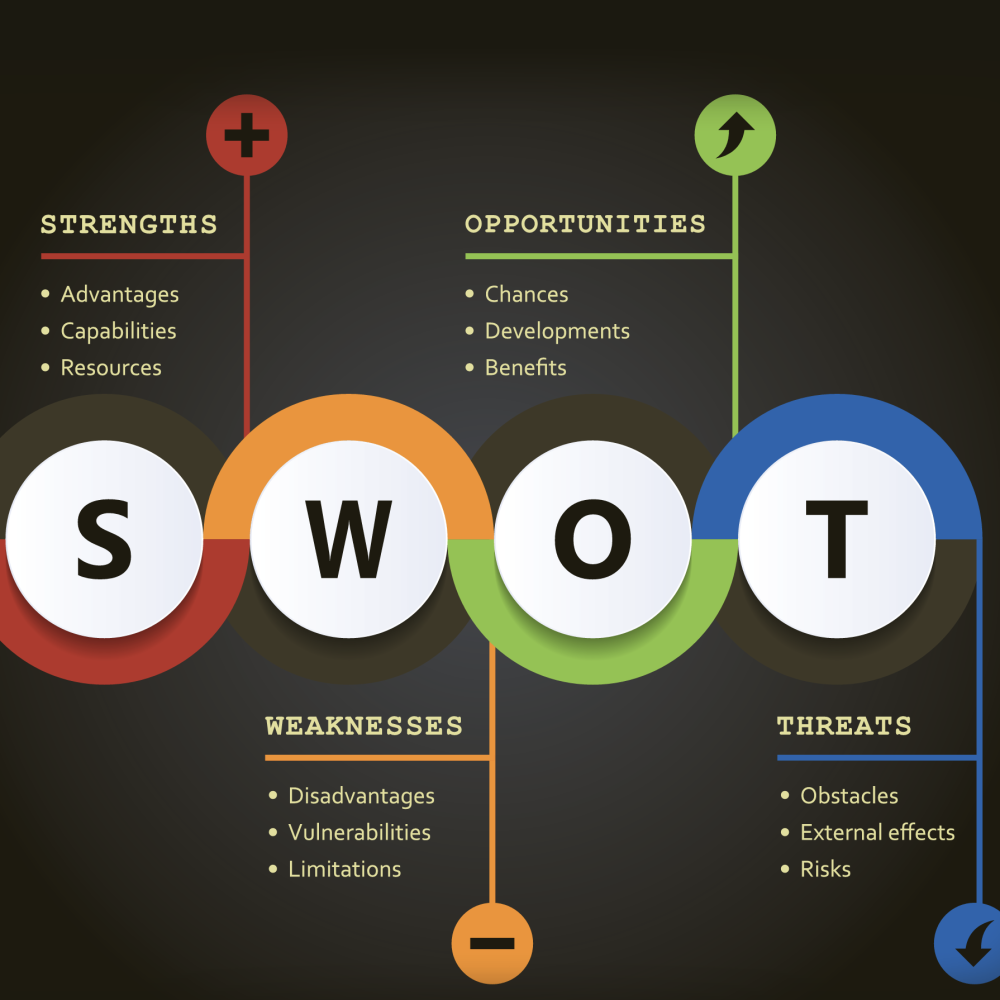
Training Pages – Crate Training
As a professional dog trainer and performer with my dogs, the first bit of advice I can give a new dog or puppy owner is the use and
importance of crating your dog
Ever heard of the SWOT Analysis? Well, it’s a super valuable tool that can help any business grow and thrive, and Chuck Holt, with New Now Services, is taking the time to contribute a continued series of “workshop” articles, designed to help you implement this tool into your dog breeding business.
Written By: Chuck Holt
In this first article, the main purpose is to give you an outline of what SWOT is and can do, and then in future articles, he’s going to actually guide you through the process, and set it up to where you personally can fill in the blanks, and come up with the answers.
So there you go, study and digest this first article, and get ready to learn as you go! This is thousands of dollars’ worth of information and coaching, all at no cost to you!
An Introduction to SWOT Analysis: Using Strategic Assessment in Developing Healthy and Thriving Kennels
It has been said, “Get the facts, or the facts will get you.” Often time in our kennel program we fail to implement a long-term plan on how we want to be successful. We often do not have goals set up to help us achieve our success and avoid costly mistakes. In the dynamic landscape of running our kennel program as a business, knowledge is power. Kennels, both big and small, constantly face challenges and opportunities that can impact their success. To navigate this complex terrain effectively, they need tools that provide insight and direction. One such invaluable tool is the SWOT analysis.
SWOT, an acronym for Strengths, Weaknesses, Opportunities, and Threats, is a basic framework that can prove very helpful in evaluating and understanding the different parts of our kennel program as a whole, or even just specific parts of it. It offers a complete overview of the internal and external factors affecting everything that is involved in running a successful kennel, helping breeders make informed decisions, and build solid systems and plans. In this article, we will delve into the fundamentals of a SWOT analysis and explore how it can be a game-changer in developing and achieving your goals.

Understanding the SWOT Analysis Framework
1. Strengths – Strengths are the internal attributes and resources that help the breeder be successful. In determining strengths, one can ask the question, “What is working well?”. At first glance it might seem hard to come up with any strengths. Our desire to live in humility and our not wanting to brag can impede us in getting a realistic view of what is going well with our kennel program. If you cannot give a reason as to why someone might buy a puppy from you, then we cannot expect the customer to do the same. Identifying strengths is crucial as they provide a foundation for building and capitalizing on opportunities.
2. Weaknesses – Weaknesses are internal factors that hinder a breeder’s ability to compete or succeed. Common weaknesses may include facility inadequacies, finances, insufficient staffing, low quality dogs, and no exercise plan, to just name a few. Recognizing weaknesses is the first step toward improvement and mitigating potential threats.
3. Opportunities – Opportunities are external factors that a breeder can leverage to their advantage. They are what is possible if you continue to maximize your strengths and minimize your weaknesses. For some, turning dreams into realities is daunting and often it takes an outside consultant to help realize what is possible, and determine the steps to get there. Identifying opportunities helps breeders tailor their strategies to tap into potential growth areas.

4. Threats – Threats are external factors that can negatively impact your kennel program. Threats are the things that will happen if you do not address your weaknesses. They often arise when we operate out of the tyranny of the urgent and do not have a game plan to achieve strengths and opportunities nor address our weaknesses. It has been said that threats are the realities when we do not operate intentionally. Being aware of threats allows kennels to prepare contingency plans and mitigate risks.
The SWOT Analysis Process
Conducting a SWOT analysis involves a structured process to gather and analyze relevant information. This is often effective when having a consultant or third-party operating as the moderator. Here’s a step-by-step guide to help you get started:
1. Determine your focus – Clearly state the purpose of your SWOT analysis. Are you assessing your kennel program as a whole or focusing on a specific part of it, like marketing, developing quality breeding stock, etc.?
2. Gather Data – Collect data on your kennel businesses internal attributes (strengths and weaknesses) and external factors (opportunities and threats). Placing each component of the SWOT analysis on a large piece of paper or post it note can help with visualizing each one. This is a mind dump and there are no right or wrong attributes or factors as long as they are true.
3. Identify Strengths and Weaknesses – Analyze your organization’s strengths and weaknesses objectively. Focus on areas such as finances, facilities, operations, systems, operations, human resources, technology, and marketing. Use metrics and data where possible to support your observations.
4. Identify Opportunities and Threats – Examine external factors that can impact your kennel program. Stay updated on industry trends, current market conditions, and competitive landscapes. Consider factors that could emerge in the future both with your kennel and in the industry. Remember, opportunities are what could happen if you maximize and continue building your strengths. Threats are what will happen if you do not address your weaknesses.

5. Strategy Development – Once you have a clear picture of your SWOT analysis, use it as a foundation for strategy development. Capitalize on your strengths, address weaknesses, seize opportunities, and devise strategies to mitigate threats. It is recommended that you go through each one and circle the top three. Then begin brainstorming what you can do to address each of them. This forms the basis for your goals and action steps.
Conclusion
SWOT analysis is not a one-time activity. It should be periodically reviewed and updated to adapt to changing circumstances and new information. SWOT analysis is an invaluable tool for strategic planning. It provides a structured approach to understanding an organization’s current position and crafting a roadmap for the future. The analysis will enhance decision-making by providing a comprehensive view of an organization’s internal and external landscape.
The complex and ever-changing world we live in affects every aspect of our lives and business. SWOT analysis can provide a compass that guides our kennel business toward its goals. By assessing internal strengths and weaknesses while remaining attuned to external opportunities and threats, New Now Services you can make informed decisions, formulate effective strategies, and remain relevant in the face of uncertainty. In the next four issues we will examine closely the four components of a SWOT analysis and walk through what it looks like for a breeder.
Bio: Chuck Holt is the president of New Now Services which exists to help plain community business and breeders become successful in today’s ever changing world. He is also the founder of the Responsible Dog Breeder Network. Chuck has been a consultant and coach for over 20 years and for the past 5 years brings that to the community by providing business coaching for breeders and businesses, photo and listing services, Responsible Dog Breeder Network, and pawTree Dog food.
Chuck is married to Claudia and has had 24 foster kids and raised 5 adopted kids, three with special needs. He and his family love to camp and enjoy raising King Charles Cavaliers.
For more information on having New Now Services provide business coaching for your kennel program, contact Chuck at 610-223-2008 or at [email protected]

As a professional dog trainer and performer with my dogs, the first bit of advice I can give a new dog or puppy owner is the use and
importance of crating your dog
And, drumroll please, here is the last part of the four part series of the Panel Discussion covering Advertising, Marketing, Branding, Social Media, Website Creation, and more. Hats off to all of the dedicated contributors that have taken the time to put their thoughts on paper.

Puppies are referred to as “neonates” during the first two weeks of life. They often sleep in a stacked heap and nurse frequently. Their eyes and ear canals are not opened. Mobility is limited as they are unable to do more than paddle with their legs and slide. Senses of smell and touch are more operational, which many scientists believe allow the puppies to maintain contact with their mother.